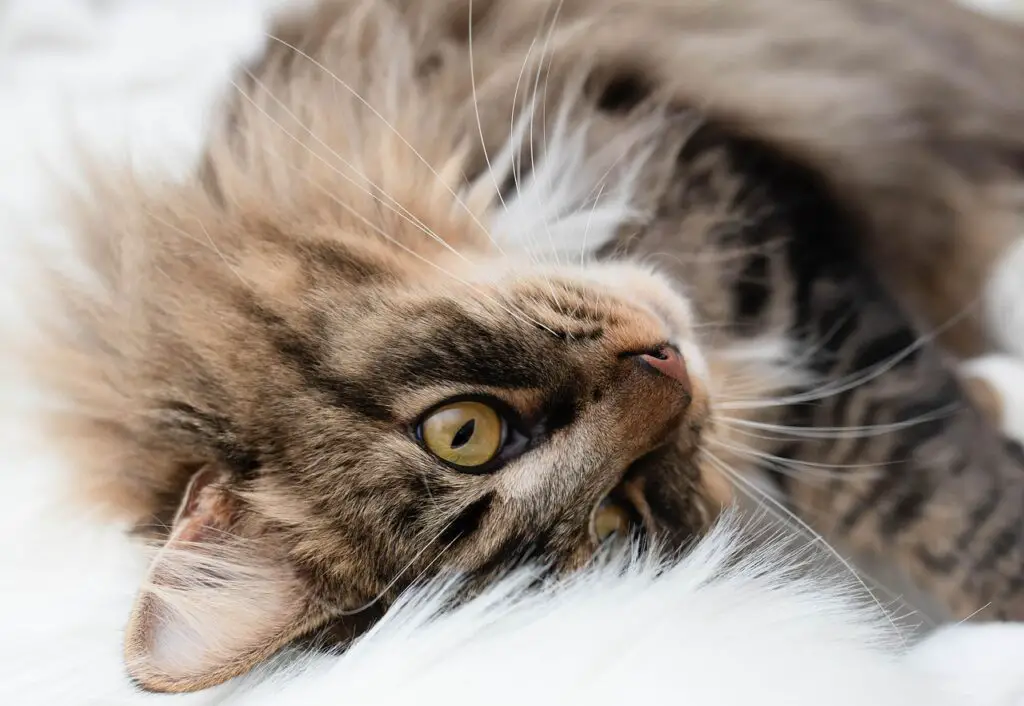Short Answer: Cats purr for various reasons, primarily to communicate contentment and relaxation. This soothing sound often occurs when they are being petted or resting comfortably. However, cats may also purr when in pain or distress, using the sound as a self-soothing mechanism. The vibrations produced during purring can promote healing and reduce stress in both cats and humans.
The gentle sound of a cat’s purr is one of nature’s most soothing melodies. For many cat owners, this sound signifies comfort and contentment. Yet, beneath its surface lies a fascinating mystery that has intrigued scientists, veterinarians, and cat lovers alike. Why do cats purr? This question opens up a window into the complex world of feline communication and behavior.
Cats are known for their unique ability to express emotions and needs through various vocalizations. Among these, purring stands out as a particularly enigmatic sound. While it is often associated with happiness, purring can also occur in moments of distress or pain. This duality raises questions about the true purpose of this comforting sound. Understanding why cats purr requires diving into their biology, psychology, and social behavior. The following table summarizes some key facts about cat purring.

| Fact | Details |
|---|---|
| Purring Frequency | Typically between 25 and 150 Hertz. |
| Common Reasons for Purring | Contentment, relaxation, pain relief, self-soothing. |
| When Cats Purr | During feeding, petting, and even when injured. |
| Who Purrs? | Domestic cats and some wild cats like cheetahs and bobcats. |
The Science Behind Purring
Purring is produced by rapid contractions of the muscles within a cat’s larynx, which causes a sudden change in airflow. This process occurs both when the cat inhales and exhales, creating the continuous sound we recognize as purring. The mechanism is quite distinct from other vocalizations cats make. Researchers have noted that the unique frequency range of purring may have therapeutic effects.
The Healing Power of Purring
Studies suggest that the vibrations from a cat’s purr may promote healing in their bodies. Frequencies around 25 to 150 Hertz have been associated with various health benefits, such as reducing pain and inflammation. This phenomenon raises intriguing questions about the evolutionary advantages of purring. It seems that not only does the sound serve as a form of communication, but it may also play a role in self-healing during times of stress or injury.
Moreover, the soothing rhythm of a cat’s purr has a calming effect on humans as well. Many cat owners report feeling relaxed and comforted when their feline companions curl up beside them and begin to purr. This mutual interaction creates a bond that deepens the human-animal connection.
Purring in Different Contexts
While many associate purring with moments of relaxation or contentment, it is important to note that cats also purr during challenging times. For example, a cat may purr when it is frightened or in pain. This behavior suggests that purring may serve multiple functions beyond just expressing happiness.
<h3.Purring During Stressful Situations
In stressful situations, such as visits to the veterinarian or during recovery from surgery, cats often resort to purring as a self-soothing mechanism. By producing this comforting sound, they might help alleviate their own anxiety while simultaneously signaling to their owners that they are in need of reassurance. Understanding this aspect of purring adds depth to our comprehension of feline emotions and instincts.
Social Functions of Purring
Purring plays a vital role in the social interactions among cats and between cats and humans. It serves as a form of communication that conveys various emotions and intentions. Understanding these social functions can enrich our relationship with our feline friends.
Bonding with Kittens
Mother cats use purring to communicate with their kittens. Newborn kittens are born blind and deaf, so they rely on tactile and auditory cues to find their mother and stay close. The sound of their mother’s purr provides comfort and reassurance, guiding them to her for warmth and nourishment.
As the kittens grow, they learn to associate the sound of purring with safety and care. This early bonding experience is crucial for their emotional development and helps shape their future interactions with other cats and humans.
Social Interactions Among Adult Cats
Among adult cats, purring can signify a range of emotions during social interactions. Here are some scenarios where purring may occur:
- Greeting Behavior: Cats may purr when they approach each other as a friendly gesture. This behavior indicates a peaceful intent and can help reduce tension during initial encounters.
- Affectionate Interactions: Cats often purr while being petted or cuddled. This signals enjoyment and satisfaction, reinforcing their bond with humans.
- Conflict Resolution: In multi-cat households, a cat may purr to calm another cat during a standoff. This sound can diffuse potential aggression and foster a more harmonious environment.
The Role of Purring in Cat Communication

Purring is just one aspect of a cat’s complex communication system. Cats also use body language, facial expressions, and other vocalizations to express their feelings. Purring can enhance these forms of communication in several ways.
Enhancing Vocal Communication
While cats have a wide range of vocalizations, purring can serve as a background sound that complements other vocal signals. For instance, a cat may meow while simultaneously purring to convey both a request for attention and an expression of contentment. This layered communication helps convey nuanced messages.

Purring as an Attention-Getter
Cats have been observed using purring strategically to attract human attention. When they want something—like food or playtime—they may purr more loudly or frequently. This behavior demonstrates their understanding of how to engage with humans effectively, showcasing their intelligence and adaptability.
The interplay between purring and other communication methods underscores the importance of attentive observation. By learning to interpret these signals, cat owners can better meet their pets’ needs and strengthen their relationships.
The Evolutionary Perspective on Purring
Understanding purring from an evolutionary standpoint provides insights into why this behavior has persisted in domestic cats and some wild relatives. This perspective highlights the adaptive advantages that purring may confer to felines in their natural environments.
Survival Mechanism
Purring is believed to have evolved as a survival mechanism. In the wild, a cat’s ability to signal calmness and non-aggression can be crucial in avoiding confrontations with other animals. This ability to communicate effectively and peacefully can improve a cat’s chances of survival by reducing the likelihood of aggressive encounters.
In addition, the soothing vibrations produced by purring may have healing properties, which could enhance a cat’s chances of survival after injury or illness. By aiding in recovery, purring allows cats to return to their normal activities more quickly.
Mother-Young Bonding
The bond between a mother cat and her kittens is critical for their survival. The use of purring by mother cats not only comforts their young but also encourages nursing. This bond is essential during the early developmental stages when kittens are most vulnerable. The evolutionary implications are significant: those kittens that are nurtured and comforted are more likely to grow into healthy adults.
Differences in Purring Among Cat Breeds
While purring is a common behavior among many cat breeds, there are variations in how different breeds exhibit this sound. Some cats are known for their particularly loud or distinctive purrs. Understanding these differences adds another layer to our appreciation of feline diversity.
Notable Breeds and Their Purring Styles
- Siamese Cats: Known for their vocal nature, Siamese cats often combine meowing with purring, creating a unique sound that is both distinct and attention-grabbing.
- Maine Coon Cats: Often referred to as “gentle giants,” Maine Coons have a deep, resonant purr that can be quite soothing. Their large size does not diminish their affectionate nature.
- Burmese Cats: These cats are known for their affectionate personalities and often purr loudly, seeking human interaction and companionship.
The differences in purring styles across breeds reflect not only genetic factors but also the environmental and social contexts in which these breeds have developed. This diversity in vocalization can influence how effectively a cat communicates its needs to humans and other animals.
Impact of Environment on Purring
The environment in which a cat lives can also affect its behavior related to purring. For instance, feral cats may not purr as frequently as domesticated cats due to their need to remain cautious in the presence of potential threats. In contrast, cats that live in safe, loving homes may purr more freely as they feel secure and relaxed.
Emotional Connection and Human Perception
The bond between cats and humans is unique, and purring plays a crucial role in this relationship. The soothing sound evokes feelings of comfort and affection in many cat owners. This emotional connection is not merely one-sided; cats also thrive on the emotional support they receive from their human companions.
The Effect of Purring on Human Psychology
Research has shown that interactions with pets can significantly reduce stress and anxiety in humans. The sound of a cat’s purr has been linked to lowering blood pressure and promoting relaxation. The calming effect of purring can create a serene atmosphere, making it easier for individuals to unwind after a long day.
Additionally, the act of petting a purring cat can release oxytocin, often referred to as the “love hormone,” in both cats and humans. This mutual exchange fosters a deeper emotional bond, enhancing the overall well-being of both parties.
Understanding Purring in Older Cats
As cats age, their behavior can change, including their purring habits. Older cats may purr more frequently due to various reasons, such as experiencing discomfort or seeking attention. It’s important for cat owners to be observant of these changes, as they can indicate underlying health issues.
Health Monitoring Through Purring
Purring can serve as an important indicator of a cat’s health status. If an older cat suddenly begins to purr more than usual or exhibits changes in their purring sound, it may signify pain or discomfort. Regular veterinary check-ups are vital for older cats to monitor their health and address any emerging issues promptly.

Final Thoughts
Purring is a multifaceted behavior that offers insights into the emotional lives of cats. From its evolutionary roots as a survival mechanism to its role in fostering social bonds, purring serves various critical functions. It provides comfort not only to the cats themselves but also to their human companions, creating a soothing environment that promotes well-being.
Understanding the complexities of why cats purr deepens our appreciation for these fascinating creatures. As we continue to bond with our feline friends, recognizing the different contexts and meanings behind their purring will enhance our interactions and strengthen our relationships. Whether expressing happiness, seeking comfort, or communicating distress, purring remains one of the most enchanting aspects of cat behavior. Through this knowledge, we can become more empathetic and responsive guardians to our beloved pets.

